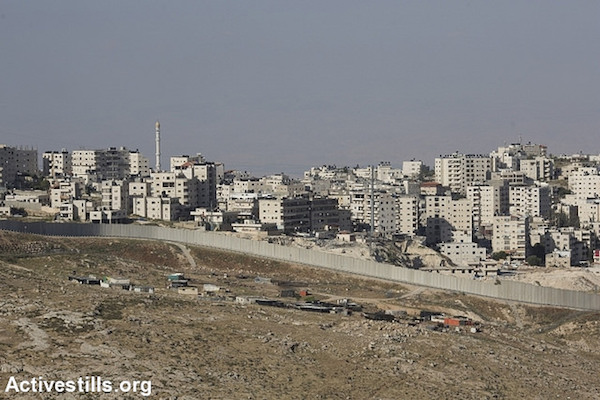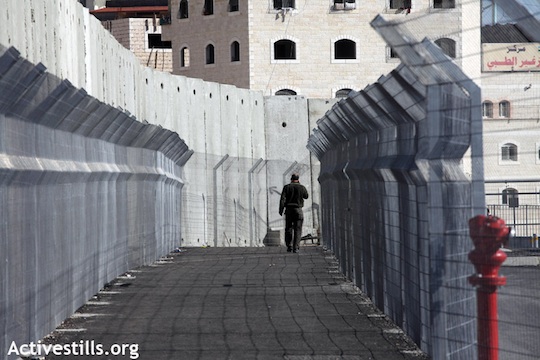It is no accident that eight Palestinian neighborhoods of Jerusalem wound up beyond the separation barrier. Since annexing Jerusalem in 1967, Israel has manipulated migratory trends toward an unstated goal: absorbing the land without the people.
By Betty Herschman

There are many ways to test the notion of Jerusalem as the undivided capital of Israel. One could do a comparative analysis of how much the municipality invests in East and West Jerusalem — roughly 1:9. One could drive up the road that neatly divides the bougainvillea draped neighborhood/settlement of East Talpiot and Palestinian Jabal Mukaber, a model of a neighborhood excluded from the city planning process; or consider that Palestinians, nearly 40 percent of the population of the city, are second-class residents denied the right to vote in national elections. For absolute clarity, one need only look at the eight Jerusalem neighborhoods that are located squarely within the municipal borders…but relegated to the other side of the separation barrier.
Findings from Ir Amim’s comprehensive new report, “Displaced in their Own City,” reveal that at least 80,000 and possibly more than 100,000 Palestinians — between one-fourth to one-third of the entire Palestinian population of Jerusalem, linked to the city for generations by ties of family, livelihood, economics, identity, culture, and religion — now live in these abandoned enclaves. The area of Kufr Aqab and Semiramis as well as the Shuafat refugee camp, including the neighborhoods of Ras Khamis, Ras Shehadeh, and Dahiyat al-Salaam, are totally, indisputably divided from Jerusalem by a concrete wall and checkpoints, as well as the municipality’s near complete abdication of responsibility for providing basic services, safety oversight and law enforcement.
Read the full report: Displaced in their Own City
From afar, these neighborhoods appear to be thriving; one sees a skyline of new development and ambitious construction rather than a sprawling, dilapidated favela. But zoom in and one sees that buildings are being erected within several meters of one another, with no municipal oversight to ensure basic engineering and safety standards. UNRWA’s project director in the Shuafat refugee camp estimates that in the event of an earthquake some 80 percent of the buildings around the earthquake-vulnerable camp will collapse. Miles of roads across the eight neighborhoods are unpaved, posing a severe health and safety hazard. In some places, sewage flows freely in the streets. There is an intolerable dearth of schools and health care services, a particularly acute problem given that Israeli ambulances will not enter the neighborhoods, requiring Palestinian ambulances to meet them at checkpoints for transfer to hospital. Delays can be fatal.
What is more shocking than the devastation itself is the realization that the neighborhoods beyond the barrier are not accidental; they are the creation of policies which, since the annexation of Jerusalem in 1967, have manipulated migratory trends toward an unstated goal: absorbing the land without the people. Israeli policy has sought to maintain territorial control over East Jerusalem and to ensure a substantial Jewish majority in the city: first, through the expropriation of one-third of Palestinian land for Israeli use and second, through the denial of Palestinian individual and collective rights (i.e. denial of full civil status and attendant social and political rights). Building on that foundation, in 2004 Israel began constructing a separation barrier around Jerusalem, ostensibly designed to serve as a security buffer. In fact, it delineated a political boundary to Jerusalem that sought to ensure a firm Jewish majority and full territorial control of the city and surrounding areas, conveniently excising eight Palestinian neighborhoods in the process.

These neighborhoods are an extreme mirror of Israeli policy in East Jerusalem, a pillar of which is Palestinians’ near complete exclusion from the planning process — and access to building permits — and the maintenance of gross socio-economic disparities to which the barrier has been a primary contributor. For the poorest of the poor (the overall poverty rate in East Jerusalem is 75.4 percent), the push-pull dynamic of housing within the barrier in East Jerusalem being cost prohibitive and the availability of more affordable albeit unsafe alternatives beyond the barrier — due to the Municipality’s disinterest — amounts to nothing less than the “silent transfer” of Palestinians to the outer perimeter of the city.
As a possible harbinger of Israel’s ultimate intentions, in 2006 security responsibility in the Kufr Aqab-Semiramis area was transferred from the Police to the Military (the IDF’s Binyamin Brigade), effectively converting civilians into subjects of a military administration. Justified by statements from various political figures, one must ask if these steps indicate intentions to relinquish the land as a trade for not locating a future Palestinian capital in East Jerusalem — in other words, unilaterally dividing Jerusalem without addressing the Historic Basin, the very heart of a political resolution on the city. Until such a resolution is reached, and so long as Israel maintains its control over East Jerusalem, the Israeli government and the Jerusalem Municipality will continue to bear responsibility for the fate of the residents of the eight neighborhoods beyond the barrier. Failure to take action will further undermine the stability of Palestinian life in Jerusalem, the democratic foundations of Israeli society and any future political resolution on the city.
Betty Herschman is director of international relations and advocacy for Ir Amim, for an Equitable and Stable Jerusalem with an Agreed Political Future.
